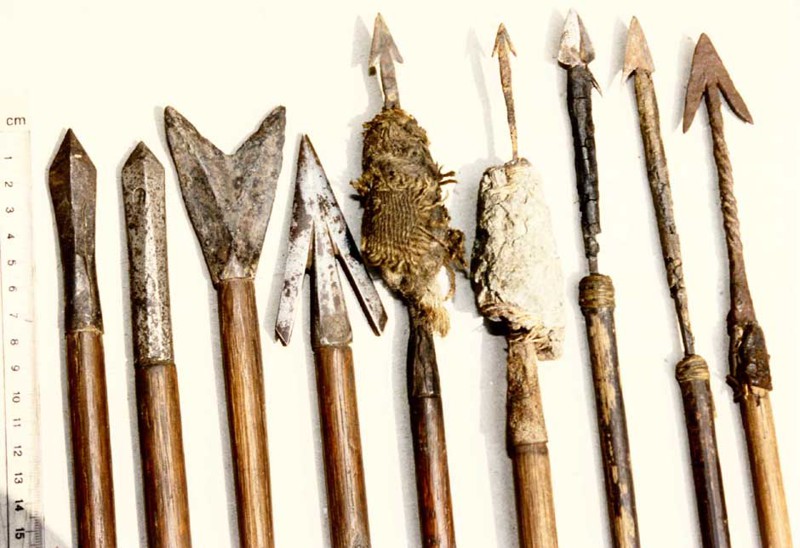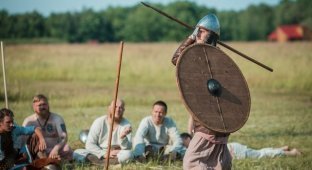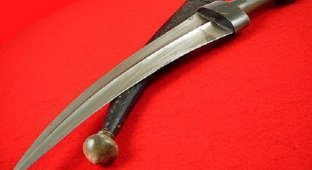I present to you a small selection of armor and weapons. Today we’re talking about what a bow is not a weapon without. So - arrows.
I warn the lazy people at once there are not just a lot of letters, but a lot. For aesthetes, I want to add - it has not been read or verified. So you are not welcome here.
Typically, an archer carried several types of arrows with him: heavy ones for long-range shooting and light ones for short-range shooting. Initially, the arrows were very light, but the development of metallurgy, and in connection with this the increased availability of metal, made it possible to increase the weight of the arrows. Such arrows retained their destructive power longer and could already penetrate armor. For example, in 1097, Prince Mstislav Svyatopolkovich was mortally wounded by a heavy arrow through his chain mail. A person not protected by a shell could be pierced through by an arrow.

For a simple 2-meter English bow, the effective firing range of 80-gram arrows did not exceed 90 meters. Powerful composite bows made it possible to increase the effective firing range of heavy arrows to 120-150 meters. Of course, 90 meters is not a bad indicator for an ancient weapon. But the slinger also threw his completely free stones at the same distance. Arrows can actually be shot two to three times further. It’s possible, of course it’s possible, but... There was such a great fun in Rus': catching arrows with your hands.

It was, of course, impossible to ensure that the arrow did not waste its already modest energy on the way to the target. But it turned out that it was possible to make sure that by the end of the journey she regained some of her energy. For very heavy arrows, the air offered relatively little resistance, and as they fell they began to accelerate again. Diving from the top point of the trajectory, the heavy arrow regained its destructive power. Heavy arrows flew 140-240 meters, but very inaccurately - often they were not even equipped with feathers. However, their use made it possible to almost double the range of effective archery. Shooting in a canopy gave the archers another valuable advantage - they got the opportunity to line up in several rows without interfering with each other. At the Battle of Crecy, English archers stood in 4 rows. This is what allowed them to fire about 500,000 arrows at the French with a total weight of 100 tons!


“A cloud of arrows” is not an exaggeration at all. And the Persians, threatening the Spartans to cover the Sun with arrows, were not joking. The bow's rate of fire remained unsurpassed until the end of the 19th century. As soon as the enemy approached the “crossfire” (the flight range of a heavy arrow), the archers opened “barrage fire,” firing 10-12 shots per minute. Even against the attacking cavalry, the archer managed to fire 4 arrows. What if the archers stood in several rows? The combat effectiveness of an archer depended entirely on his supply of ammunition. If we consider that at Crecy all the French knights, protected by chain mail, were directly or indirectly hit by arrows, then about 300 pieces were spent on each of them! About 10 kilograms of iron alone! At the battle of Carrhae, 10,000 Parthians, “constantly returning to the baggage train to refill their quivers,” fired at least a million arrows at the Romans. But the Romans lost only 4 thousand (the consumption of 250 arrows per enemy soldier who was incapacitated).

They carried arrows in a quiver. But the portable ammunition was not particularly large. The quiver could hold no more than forty arrows. And the archers, having used up all their arrows, often collected the arrows fired by the enemy and shot them back. And they were brought arrows from the convoy. The arrows in the quiver were placed with the feathers facing up. Since arrows with tips for various purposes were stored in one quiver (armor-piercing - against helmets, shields and shells; cutting - against enemy cavalry and enemy warriors unprotected by armor, etc.), the arrow shafts at the eye and tail were painted in different colors so that it was possible to quickly remove the desired arrow.
Various arrowheads.

Arrows became one of the first mass-produced goods. Fortresses and armies purchased them in batches of tens of thousands. And the shaft of the arrow was not cut from any branch at all! A piece of log 1 to 1.5 meters long needed to be split lengthwise into thin strips. Then four strips with different fiber directions were glued together longitudinally, forming a blank for the shaft. This was the only way to make hardened arrows that did not bend when dry and were suitable for long-term storage. The production of arrows was a separate craft specialty. And in Moscow, shooters’ workshops at one time occupied an entire street - Strelnya.


The components of an arrow are the shaft, the tip and the fletching. The shaft - the main part of the arrow, which provided the direction of flight, was a round wooden or reed straight rod. A tip, feathering, and sometimes a bone or other eyelet for attaching to a bowstring were attached to the shaft. Most arrows have a eye cut into the shaft itself.

The arrowhead ensured the effectiveness of destruction, the plumage ensured stability in flight and shooting accuracy. The arrow had to be strong and light. In Rus', arrows were made from pine, spruce, birch, and less often from other species. The length of Old Russian arrows ranged from 75 to 90 cm (rarely more), thickness from 7 to 10 mm. But the size of Russian bows was not large. The surface of the arrow shaft must be flat and smooth, otherwise the shooter will seriously injure his hand. The arrow shafts were processed using bone knife blades and grinding stones made of sandstone and other types of stone.

Arrowheads were mounted on the shaft in two ways, depending on the shape of the attachment: bushing or stalk. The socketed tips were put on the shaft, and the stalked ones were inserted into the end of the shaft. Both attachment and driving were done using glue for strength. After fitting, the petiole tips were secured with a winding of glue to prevent the shaft from splitting. On top of the winding, the end of the shaft was covered with a thin strip of birch bark so that the roughness did not reduce the flight speed and did not cause deviations in flight

An eyelet was cut out at the back end of the shaft, where the bowstring entered during tension. Without the eye, the arrow would jump off the string during drawing and aiming. The ear should be neither too shallow nor too deep. A deep eye slows down the flight of the arrow, and in a shallow eye the arrow sits precariously on the string. Old Russian arrow shafts had ears 5-8 mm deep (very rarely up to 12 mm) and 4-6 mm wide. In addition, there were bone lugs (butts). The attachment lugs had a petiole for reed shafts and a bushing for attaching to a wooden shaft. The end of the shaft, after fitting the eye, was also wrapped with thread and covered with birch bark. This winding also secured the lower end of the arrow's feathers.

The feathering gave the arrow stability in flight and contributed to more accurate shooting at the target. The plumage of arrows is repeatedly mentioned in chronicles, epics and other sources and is depicted on monuments of art. The feathers of the arrows came from the wings of various birds. They had to be smooth, elastic, straight, but not rigid. In Rus' the plumage was two to four feathers. The most commonly used plumage was two feathers. The length of the fletching was most often used 12 - 15 cm. It retreated from the eye by 2 - 3 cm to make it convenient to take the arrow. The blades of the feathers should have the same length and width (1 - 2 cm) and bend in one direction, which gives the arrow helical rotation and stability in flight. The length and width of the plumage depended on the massiveness of the arrow.

The shape of the arrowheads depended on the purpose for which the arrows were intended. For shooting at an enemy unprotected by armor and at enemy horses, the most effective were three-bladed and flat wide arrowheads, which inflicted wide wounds, causing severe bleeding and thereby quickly incapacitating a foot or mounted enemy. In Ancient Rus', arrows with wide cutting tips were called shears. Double-horned points, judging by ethnographic data, were used for shooting waterfowl. The widespread use of protective armor caused the spread of armor-piercing steel arrowheads, capable of piercing almost any metal armor. It was at this time that armor-piercing tips appeared and spread, so to speak, with a narrow specialization. For piercing chain mail - tips with a narrow, awl-shaped, massive head. For plate armor, helmets and shields - narrow, massive chisel-shaped tips and armor-piercing tips with a faceted head. Chisel tips were especially effective when shooting at an enemy protected by a helmet and shield. Such tips easily split a wooden shield covered with leather and sometimes reinforced with an iron umbo.


The Arabic manual for archery recommended that the weight of a light arrow be between 15 and 20 dirhams (42 - 57 g) and that the weight of the tip should be 1/7 of the weight of the arrow, and the weight of the fletching should be 1/7 of the weight of the tip. These figures are very close to the weight ratios of Russian arrows. The weight of most ancient Russian light arrowheads is 8 - 10 g, heavy ones up to 20 g.
In addition to military, hunting and fishing arrows, incendiary arrows were also used in Rus'. True, they were used very rarely and they were not typical for Russian warriors. They always had a tip designed to catch on the roof and cause a fire.

In fantasy, incredibly fast heroes often deflect arrows with swords. Is this technique a free flight of fancy? No. In 2002, Australian Anthony Kelly managed to catch with his hands 23 paintballs fired at him at a speed of 60 meters per second from a distance of 20 meters. According to Kelly, it was much easier for him to catch arrows with his hands, since the arrows are long and fly much slower. However, more often than not, arrows were repelled with shields rather than with blades. And this was quite common practice.

In Assyria, for example, each archer was covered by a warrior with a small and light shield. Describing the battle of the Graupian Mountains, Tacitus reports that the ancient Britons had the same custom. While some showered the Romans with arrows, others skillfully repelled enemy arrows with shields. After all, an arrow should not be confused with a bullet. In order to cover a distance of 90 meters, a heavy arrow from an English archer needed about 4 seconds! Therefore, in battle, the British aimed at shooting light arrows only at 30 meters, and Russian and Asian shooters at 60 meters. Armor up to and including chain mail was pierced by a light arrow from a long English bow from 70 m, and by a heavy arrow at a distance of up to 150 m. But plate armor was not pierced by the arrows of English archers. Unlike the arrows of Russian archers.


























